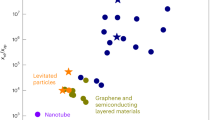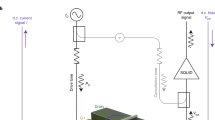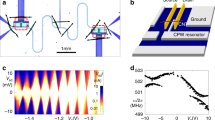Abstract
The coupling between electrons and phonons is at the heart of many fundamental phenomena in nature. Despite tremendous advances in controlling electrons or phonons in engineered nanosystems, control over their coupling is still widely lacking. Here we demonstrate the ability to fully tailor electron–phonon interactions using a new class of suspended carbon nanotube devices, in which we can form highly tunable single and double quantum dots at arbitrary locations along a nanotube mechanical resonator. We find that electron–phonon coupling can be turned on and off by controlling the position of a quantum dot along the resonator. Using double quantum dots we structure the interactions in real space to couple specific electronic and phononic modes. This tailored coupling allows measurement of the phonons’ spatial parity and imaging of their mode shapes. Finally, we demonstrate coupling between phonons and internal electrons in an isolated system, decoupled from the random environment of the electronic leads, a crucial step towards fully engineered quantum-coherent electron–phonon systems.
This is a preview of subscription content, access via your institution
Access options
Subscribe to this journal
Receive 12 print issues and online access
$209.00 per year
only $17.42 per issue
Buy this article
- Purchase on Springer Link
- Instant access to full article PDF
Prices may be subject to local taxes which are calculated during checkout





Similar content being viewed by others
References
Kastner, M. A. Artificial atoms. Phys. Today 46, 24–31 (1993).
Ekinci, K. L. & Roukes, M. L. Nanoelectromechanical systems. Rev. Sci. Instrum. 76, 061101 (2005).
Poot, M. & van der Zant, H. S. J. Mechanical systems in the quantum regime. Phys. Rep. 511, 273–335 (2012).
LaHaye, M. D., Buu, O., Camarota, B. & Schwab, K. C. Approaching the quantum limit of a nanomechanical resonator. Science 304, 74–77 (2004).
O’Connell, A. D. et al. Quantum ground state and single-phonon control of a mechanical resonator. Nature 464, 697–703 (2010).
Teufel, J. D. et al. Sideband cooling of micromechanical motion to the quantum ground state. Nature 475, 359–363 (2011).
Chan, J. et al. Laser cooling of a nanomechanical oscillator into its quantum ground state. Nature 478, 89–92 (2011).
Arcizet, O. et al. A single nitrogen-vacancy defect coupled to a nanomechanical oscillator. Nature Phys. 7, 879–883 (2011).
Kolkowitz, S. et al. Coherent sensing of a mechanical resonator with a single-spin qubit. Science 335, 1603–1606 (2012).
LaHaye, M. D., Suh, J., Echternach, P. M., Schwab, K. C. & Roukes, M. L. Nanomechanical measurements of a superconducting qubit. Nature 459, 960–964 (2009).
Aspelmeyer, M., Meystre, P. & Schwab, K. Quantum optomechanics. Phys. Today 65, 29 (2012).
Cao, J., Wang, Q. & Dai, H. Electron transport in very clean, as-grown suspended carbon nanotubes. Nature Mater. 4, 745–749 (2005).
Kuemmeth, F., Ilani, S., Ralph, D. C. & McEuen, P. L. Coupling of spin and orbital motion of electrons in carbon nanotubes. Nature 452, 448–452 (2008).
Steele, G. A., Gotz, G. & Kouwenhoven, L. P. Tunable few-electron double quantum dots and Klein tunnelling in ultraclean carbon nanotubes. Nature Nanotech. 4, 363–367 (2009).
Sazonova, V. et al. A tunable carbon nanotube electromechanical oscillator. Nature 431, 284–287 (2004).
Leturcq, R. et al. Franck–Condon blockade in suspended carbon nanotube quantum dots. Nature Phys. 5, 327–331 (2009).
Hüttel, A. K. et al. Carbon nanotubes as ultrahigh quality factor mechanical resonators. Nano Lett. 9, 2547–2552 (2009).
Ganzhorn, M. & Wernsdorfer, W. Dynamics and dissipation induced by single-electron tunneling in carbon nanotube nanoelectromechanical systems. Phys. Rev. Lett. 108, 175502 (2012).
Lassagne, B. et al. Coupling mechanics to charge transport in carbon nanotube mechanical resonators. Science 325, 1107–1110 (2009).
Steele, G. A. et al. Strong coupling between single-electron tunnelling and nanomechanical motion. Science 325, 1103–1107 (2009).
Woodside, M. T. & McEuen, P. L. Scanned probe imaging of single-electron charge states in nanotube quantum dots. Science 296, 1098–1101 (2002).
Waissman, J. et al. Realization of pristine and locally tunable one-dimensional electron systems in carbon nanotubes. Nature Nanotech. 8, 569–574 (2013).
Meerwaldt, H. B. et al. Probing the charge of a quantum dot with a nanomechanical resonator. Phys. Rev. B 86, 115454 (2012).
Garcia-Sanchez, D. et al. Mechanical detection of carbon nanotube resonator vibrations. Phys. Rev. Lett. 99, 085501 (2007).
Frey, T. et al. Dipole coupling of a double quantum dot to a microwave resonator. Phys. Rev. Lett. 108, 046807 (2012).
Petersson, K. D. et al. Circuit quantum electrodynamics with a spin qubit. Nature 490, 380–383 (2012).
Hanson, R., Kouwenhoven, L. P., Petta, J. R., Tarucha, S. & Vandersypen, L. M. K. Spins in few-electron quantum dots. Rev. Mod. Phys. 79, 1217–1265 (2007).
Pei, F., Laird, E. A., Steele, G. A. & Kouwenhoven, L. P. Valley-spin blockade and spin resonance in carbon nanotubes. Nature Nanotech. 7, 630–4 (2012).
Cirac, J. & Zoller, P. Quantum computations with cold trapped ions. Phys. Rev. Lett. 74, 4091–4094 (1995).
Turchette, Q. et al. Deterministic entanglement of two trapped ions. Phys. Rev. Lett. 81, 3631–3634 (1998).
Acknowledgements
We acknowledge O. Auslaender, E. Berg, F. Kuemmeth, P. L. McEuen, A. Shnirman and A. Yacoby for useful discussions and comments on the manuscript, and D. Mahalu for the electron-beam writing. S.I. acknowledges the financial support by the Legacy Heritage Foundation (ISF, No. 1267/12), the Bi-National Science Foundation (BSF, No. 710647-03), the Minerva foundation (No. 780054), the ERC starters grant (QUANT-DES-CNT, No. 258753), the Marie Curie People grant (IRG, No. 239322), and the Alon fellowship. S.I. is incumbent of the Z. William and E. B. Novick career development chair. F.v.O. acknowledges support through Schwerpunktprogramm SPP 1459, SFB 658 and a Helmholtz Virtual Institute.
Author information
Authors and Affiliations
Contributions
A.B., A.H. and S.I. performed the experiments, analysed the data and contributed to its theoretical interpretation. S.V.K. and F.v.O. developed the theoretical model.
Corresponding author
Ethics declarations
Competing interests
The authors declare no competing financial interests.
Supplementary information
Supplementary Information
Supplementary Information (PDF 1741 kb)
Rights and permissions
About this article
Cite this article
Benyamini, A., Hamo, A., Kusminskiy, S. et al. Real-space tailoring of the electron–phonon coupling in ultraclean nanotube mechanical resonators. Nature Phys 10, 151–156 (2014). https://doi.org/10.1038/nphys2842
Received:
Accepted:
Published:
Issue Date:
DOI: https://doi.org/10.1038/nphys2842
This article is cited by
-
Extreme mechanical tunability in suspended MoS2 resonator controlled by Joule heating
npj 2D Materials and Applications (2023)
-
Steady-state Peierls transition in nanotube quantum simulator
npj Quantum Information (2023)
-
Cooling and self-oscillation in a nanotube electromechanical resonator
Nature Physics (2020)
-
Suspended superconducting weak links from aerosol-synthesized single-walled carbon nanotubes
Nano Research (2020)
-
Nanomechanical pump–probe measurements of insulating electronic states in a carbon nanotube
Nature Nanotechnology (2019)



